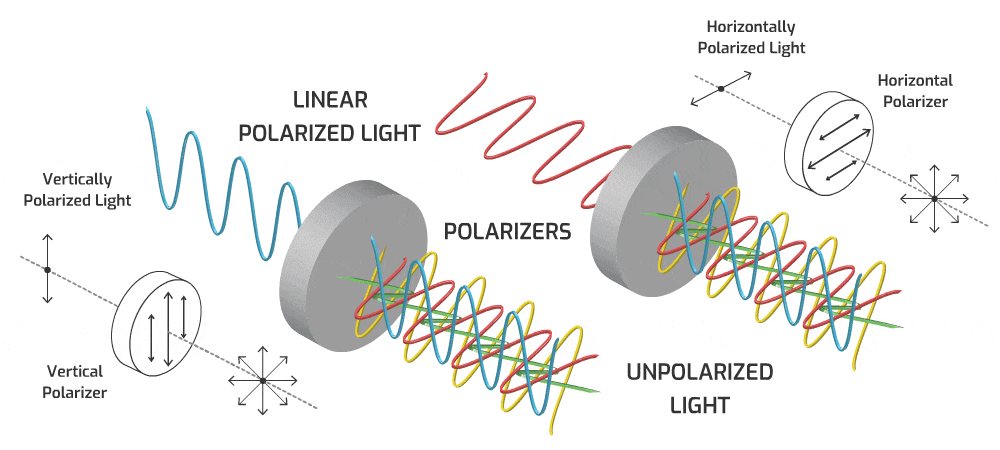In a series of experiments, we explored the effects of intention on two properties of light: polarization and scattering.
A light source like the sun or a lightbulb casts light oscillating in all angles perpendicular to the direction of travel. Polarizers allow us to select the angle of oscillation (a.k.a., the polarization) of light.
For example, when we pass light through a vertical polarizer, it will block out all the light that is not oscillating vertically. When we pass light through a horizontal polarizer, it will block out all light that is not oscillating horizontally.

Visually, this will look like light becoming dimmer when it’s passed through a polarizer; think of the last time you wore polarized sunglasses.
We passed a laser beam consecutively through horizontal and vertical polarizers — eliminating virtually all light. Passing the beam through the horizontal polarizer eliminated light that was not oscillating horizontally. When that horizontal light hit the vertical polarizer about 20 centimeters away (which only allows vertical light to pass through), then very little light came out the other side into the camera. In an ideal world where the polarizers could be set up to be perfectly, no light would pass through.
We hypothesized that if intention affected the photons’ plane of polarization, then the illumination intensity of the beam exiting the second polarizer should increase.
This idea was inspired by the Faraday effect, where a magnetic field can rotate the polarization of light. So for example, if the horizontal light we passed through the first polarizer became just slightly twisted, then the second vertical polarizer would allow slightly more light to pass through (because the light it’s receiving is no longer perfectly horizontal).
What if human intention could do the same?
In other words, we hypothesized that human intention could “twist” the beam of light — between the time it exited the first polarizer and hit the second polarizer — resulting in greater intensity illumination, as measured by the camera.
For our experiments, participants sat about a meter from the polarizer set up. They were instructed to either relax or concentrate on the light in the space between the polarizers. When they relaxed, they took their attention away from the light. When they concentrated, they directed their attention toward the light with the intention to twist it.
We were surprised to find that the intensity of illumination decreased during attention periods. Photons seemingly disappeared into empty air, either by absorption into something, scattering off of something, or converting into another frequency by interacting with something.
With this new finding in mind, we designed a follow-up experiment. This time, our hypothesis was: If human attention is directed at a beam of light with the intention to scatter it, then the light will diffuse, and less light will be received by a camera at the exit.
For this experiment, we drilled holes through opposite sides of a hollow metal sphere so that a laser beam could pass through it vertically. The sphere was painted bright white inside. The white paint caused any scattered light to be uniformly bounced around the inside of the sphere.
Any scattering of the laser light inside the sphere would cause the inside of the sphere to become more illuminated, as measured by a photodetector. The laser beam exited the sphere and directly into a camera that measured the beam intensity.
Again, participants were asked to either relax or concentrate.
And again, the results surprised us.
The camera detected an increase in beam intensity after passing through the sphere, and the photodetector showed that light bouncing around the inside of the sphere decreased. This means that there was less scattered light during the concentration sessions. Carefully matched control sessions showed none of these unexpected results.
In other words, intention appeared to play a role in influencing either the beam itself or possibly the apparatus measuring the beam.
These studies tie into the larger question of how intention can influence reality, like small stepping stones toward understanding the role of consciousness in the physical world.
